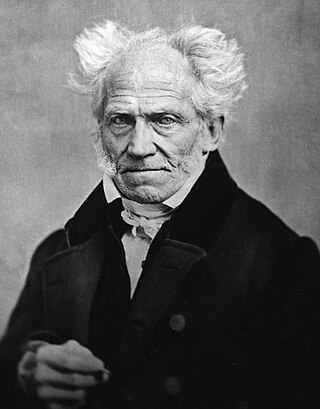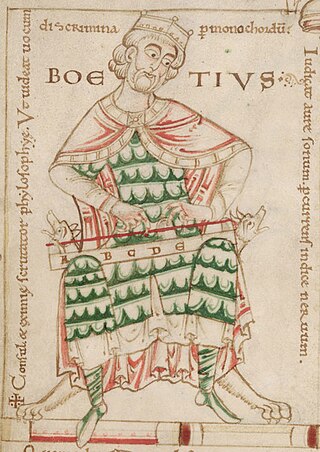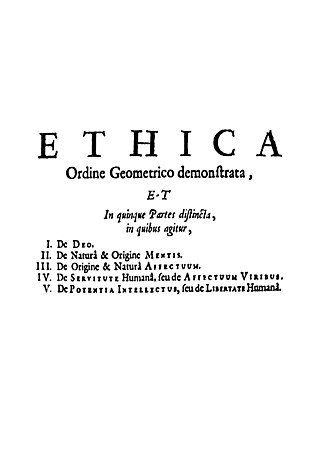
Arthur Schopenhauer was a German philosopher. He is known for his 1818 work The World as Will and Representation, which characterizes the phenomenal world as the manifestation of a blind and irrational noumenal will. Building on the transcendental idealism of Immanuel Kant (1724–1804), Schopenhauer developed an atheistic metaphysical and ethical system that rejected the contemporaneous ideas of German idealism.
In classical rhetoric and logic, begging the question or assuming the conclusion is an informal fallacy that occurs when an argument's premises assume the truth of the conclusion. Historically, begging the question refers to a fault in a dialectical argument in which the speaker assumes some premise that has not been demonstrated to be true. In modern usage, it has come to refer to an argument in which the premises assume the conclusion without supporting it. This makes it more or less synonymous with circular reasoning.
Dialectic, also known as the dialectical method, refers originally to dialogue between people holding different points of view about a subject but wishing to arrive at the truth through reasoned argumentation. Dialectic resembles debate, but the concept excludes subjective elements such as emotional appeal and rhetoric. It has its origins in ancient philosophy and continued to be developed in the Middle Ages.

A fallacy, is the use of invalid or otherwise faulty reasoning in the construction of an argument that may appear to be well-reasoned if unnoticed. The term was introduced in the Western intellectual tradition by the Aristotelian De Sophisticis Elenchis.

In traditional logic, a contradiction occurs when a proposition conflicts either with itself or established fact. It is often used as a tool to detect disingenuous beliefs and bias. Illustrating a general tendency in applied logic, Aristotle's law of noncontradiction states that "It is impossible that the same thing can at the same time both belong and not belong to the same object and in the same respect."

Anicius Manlius Severinus Boethius, commonly known simply as Boethius, was a Roman senator, consul, magister officiorum, historian, and philosopher of the Early Middle Ages. He was a central figure in the translation of the Greek classics into Latin, a precursor to the Scholastic movement, and, along with Cassiodorus, one of the two leading Christian scholars of the 6th century. The local cult of Boethius in the Diocese of Pavia was sanctioned by the Sacred Congregation of Rites in 1883, confirming the diocese's custom of honouring him on the 23 October.

Transcendental idealism is a philosophical system founded by German philosopher Immanuel Kant in the 18th century. Kant's epistemological program is found throughout his Critique of Pure Reason (1781). By transcendental Kant means that his philosophical approach to knowledge transcends mere consideration of sensory evidence and requires an understanding of the mind's innate modes of processing that sensory evidence.

Arthur Schopenhauer's aesthetics result from his philosophical doctrine of the primacy of the metaphysical Will as the Kantian thing-in-itself, the ground of life and all being. In his chief work, The World as Will and Representation, Schopenhauer thought that if consciousness or attention is fully engrossed, absorbed, or occupied with the world as painless representations or images, then there is no consciousness of the world as painful willing. Aesthetic contemplation of a work of art provides just such a state—a temporary liberation from the suffering that results from enslavement to the will [need, craving, urge, striving] by becoming a will-less spectator of "the world as representation" [mental image or idea]. Art, according to Schopenhauer, also provides essential knowledge of the world's objects in a way that is more profound than science or everyday experience.

In Kantian philosophy, the thing-in-itself is the status of objects as they are, independent of representation and observation. The concept of the thing-in-itself was introduced by the German philosopher Immanuel Kant, and over the following centuries was met with controversy among later philosophers. It is closely related to Kant's concept of noumena or the objects of inquiry, as opposed to phenomena, its manifestations.
The principle of sufficient reason states that everything must have a reason or a cause. The principle was articulated and made prominent by Gottfried Wilhelm Leibniz, with many antecedents, and was further used and developed by Arthur Schopenhauer and Sir William Hamilton, 9th Baronet.

The Topics is the name given to one of Aristotle's six works on logic collectively known as the Organon. In Andronicus of Rhodes' arrangement it is the fifth of these six works.

Anthony Clifford Grayling is a British philosopher and author. He was born in Northern Rhodesia and spent most of his childhood there and in Nyasaland. In 2011 he founded and became the first Master of New College of the Humanities, an independent undergraduate college in London. Until June 2011, he was Professor of Philosophy at Birkbeck, University of London, where he taught from 1991. He is also a supernumerary fellow of St Anne's College, Oxford, where he formerly taught.

Ethics, Demonstrated in Geometrical Order, usually known as the Ethics, is a philosophical treatise written in Latin by Baruch Spinoza. It was written between 1661 and 1675 and was first published posthumously in 1677.

On the Fourfold Root of the Principle of Sufficient Reason is an elaboration on the classical principle of sufficient reason, written by German philosopher Arthur Schopenhauer as his doctoral dissertation in 1813. The principle of sufficient reason is a powerful and controversial philosophical principle stipulating that everything must have a reason or cause. Schopenhauer revised and re-published it in 1847. The work articulated the centerpiece of many of Schopenhauer's arguments, and throughout his later works he consistently refers his readers to it as the necessary beginning point for a full understanding of his further writings.

In philosophy and rhetoric, eristic refers to an argument that aims to successfully dispute another's argument, rather than searching for truth. According to T.H. Irwin, "It is characteristic of the eristic to think of some arguments as a way of defeating the other side, by showing that an opponent must assent to the negation of what he initially took himself to believe." Eristic is definedby Rankin as arguing for the sake of conflict, as opposed to resolving conflict.
Logic is the formal science of using reason and is considered a branch of both philosophy and mathematics and to a lesser extent computer science. Logic investigates and classifies the structure of statements and arguments, both through the study of formal systems of inference and the study of arguments in natural language. The scope of logic can therefore be very large, ranging from core topics such as the study of fallacies and paradoxes, to specialized analyses of reasoning such as probability, correct reasoning, and arguments involving causality. One of the aims of logic is to identify the correct and incorrect inferences. Logicians study the criteria for the evaluation of arguments.
A priori and a posteriori are Latin phrases used in philosophy to distinguish types of knowledge, justification, or argument by their reliance on experience. A priori knowledge is independent from any experience. Examples include mathematics, tautologies and deduction from pure reason. A posteriori knowledge depends on empirical evidence. Examples include most fields of science and aspects of personal knowledge.
On Vision and Colors is a treatise by Arthur Schopenhauer that was published in May 1816 when the author was 28 years old. Schopenhauer had extensive discussions with Johann Wolfgang von Goethe about the poet's Theory of Colours of 1810, in the months around the turn of the years 1813 and 1814, and initially shared Goethe's views. Their growing theoretical disagreements and Schopenhauer's criticisms made Goethe distance himself from his young collaborator. Although Schopenhauer considered his own theory superior, he would still continue to praise Goethe's work as an important introduction to his own.

Parerga and Paralipomena is a collection of philosophical reflections by Arthur Schopenhauer published in 1851. The selection was compiled not as a summation of or introduction to Schopenhauer's philosophy, but as augmentary readings for those who had already embraced it, although the author maintained it would be comprehensible and of interest to the uninitiated nevertheless. The collection is divided into two volumes, covering first the parerga and thereafter the paralipomena to that philosophy. The parerga are six extended essays intended as supplementary to the author's thought. The paralipomena, shorter elaborations divided by topic into thirty-one subheadings, cover material hitherto unaddressed by the philosopher but deemed by him to be complementary to the parerga.
The following is a list of the major events in the history of German idealism, along with related historical events.












